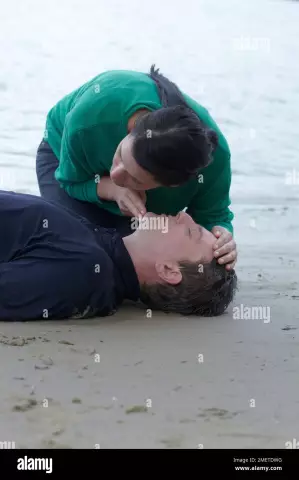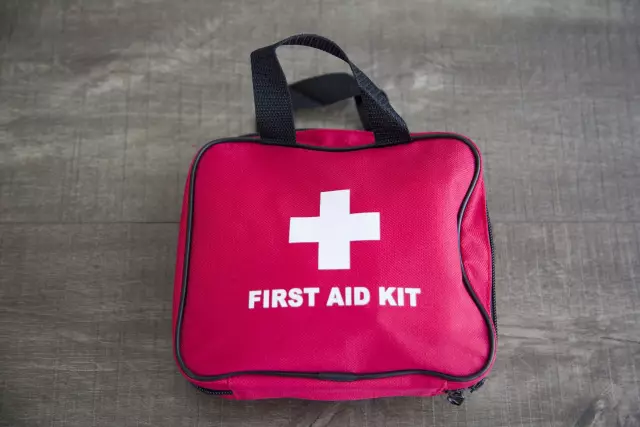- Author Curtis Blomfield [email protected].
- Public 2023-12-16 20:44.
- Last modified 2025-01-23 17:01.
How long does a person stay alive if he loses the ability to breathe? Brain cells remain viable under hypoxic conditions for no more than 5-6 minutes. Although drowning in cold water, this time may increase. In any case, assistance to the victim should be provided even before the arrival of the medical team. In this situation, the matter is decided by minutes. That's why knowing how to help is so important.
Not all people, however, are ready to answer the question, and even more so to show in practice how to act correctly in case of drowning. And this is very sad. For some reason, many believe that only employees of specialized services should have such skills, while an ordinary person, far from medicine, does not need to know this. But life sometimes puts people in difficult situations. It is very scary to see a loved one die and not know how to help him.

What is drowning?
This is a life-threatening condition characterized by the inability to breathe as a result of a person falling into water or other liquid. Often, the airways are filled with water, although this is not strictly necessary. Death from respiratory failure can occur even if the lungs remain "dry". Bythis sign, by the way, distinguishes different types of drowning.
Classification by mechanism leading to death
Types of drowning and their characteristics:
- True drowning. It is called so because in this case water (or other liquid) enters the lungs. The pathological processes underlying true drowning differ depending on whether the drowning occurred in fresh or s alt water. In the first case, water quickly penetrates from the alveoli into the vascular bed, thinning the blood and destroying red blood cells. S alt water, on the contrary, promotes the release of plasma from the vessels, which is accompanied by thickening of the blood, as well as the development of pulmonary edema.
- Asphyxial drowning. In this case, water does not enter the lungs, as the glottis closes, protecting the airways from the penetration of fluid into them. However, breathing still becomes impossible, because with laryngospasm, air is also not allowed to pass. A person dies of suffocation.
- Syncope drowning. The main cause of death is reflex cardiac arrest. The lungs remain dry. A similar situation is possible when drowning in very cold water.

Classification according to the color of the skin of the victim
Types of drowning by skin color:
- White asphyxia. As the name suggests, it is characterized by a pronounced pallor of the skin. Occurs if there is no flooding of the respiratory tract with liquid. This type is most characteristic of the syncope mechanism of drowning,when death occurs as a result of cardiac arrest.
- Blue asphyxia. It occurs when the victim makes respiratory movements, as a result of which the lungs fill with water. The skin becomes bluish in color due to severe hypoxia. Death occurs due to respiratory failure. Cardiac arrest occurs after breathing stops.
The appearance of the victim
Different types of drowning have certain differences in clinical manifestations.
If the victim was conscious at the time of immersion in water, the scenario for the development of events looks something like this. A person tries to escape by swallowing water. Breathing becomes impossible, the body experiences hypoxia, as a result of which a characteristic bluish coloration of the skin appears. Often there is an expansion of the veins of the neck. Pink foam comes out of the mouth. If a person is removed from the water during the agony phase, breathing and heart activity may still be present.

If drowning was preceded by depression of the central nervous system (intoxication, poisoning, intoxication), laryngospasm often occurs. The lungs do not fill with water, but death also occurs as a result of asphyxia. The skin becomes bluish.
Syncopal drowning occurs against a background of severe fright or cold shock. In the first place in the pathogenesis comes the cessation of cardiac activity. The skin is pale, there is no discharge of liquid and foam from the nose and mouth that is characteristic of other types of drowningthe victim. White asphyxia is the most favorable for resuscitation, the time of clinical death with it can be significantly lengthened.
Basic principles of drowning rescue
The types of drowning are varied and require different approaches to care, but the general principles remain the same in all cases.
All events include 2 stages:
- Removing the victim from the water.
- Providing assistance ashore.
How to rescue a drowning person?
No matter how different types of drowning are from each other, first aid for drowning should begin with ensuring the safety of the rescuer himself. A drowning person (if he is still conscious) can behave extremely inappropriately. That is why, when pulling the victim out of the water, care should be taken. Otherwise, the lifeguard runs the risk of becoming a drowning man himself.

If a person is close enough to the shore, you can try to reach him with a stick, use a rope or other devices to pull him out. If the victim is too far away, you will have to swim to get to him. The main thing in this situation is not to forget about the danger, because the victim can drown his savior. Therefore, you need to act quickly and unceremoniously. It is best to swim up to the drowning man from behind and wrap one hand around his neck, you can grab his hair (this is even more reliable), and then pull him to land as soon as possible.
Remember: no need to get into the water ifyou swim badly yourself!

Types of drowning, first aid for drowning. Shore activities
There are different types of drowning, and their symptoms are discussed above. This knowledge must be taken into account when assisting the victim.
- Everything is extremely simple, if the person taken out of the water is conscious. The main actions will be to warm him up and calm him down.
- If the person is unconscious, the first thing to do is remove the water from the airways. With white asphyxia, this is not necessary (the mechanism of this type of drowning is discussed above), you can immediately start resuscitation.
- With the blue type of drowning, first we clean the mouth and nose from algae, sand, etc. Then we press on the root of the tongue, thereby determining the presence of a gag reflex. The preservation of the latter means that the victim is alive, so the primary task will be to remove water from the lungs and stomach. For this, we turn the victim on his stomach, turn his head to one side, make him vomit several times, press on his chest. Then we repeat these steps every 5-10 minutes until water stops coming out of the mouth and nose. It is necessary to monitor breathing and pulse, be ready to perform resuscitation.
- If there is no gag reflex, it is urgent to check the presence of vital functions. Most likely they won't. Therefore, one should not spend a lot of time on removing water from the lungs (no more than 1-2 minutes), but proceed as soon as possible toresuscitation.

Types of drowning. Features of resuscitation in case of drowning
The above were different approaches to helping the victim. There are different types of drowning, it is not surprising that they require different measures. However, cardiopulmonary resuscitation is always performed according to a specific plan, which is not affected by the causes that led to clinical death.
What is included in the revitalization package?
- Restoration of airway patency.
- CPR.
- Card Compression.
No matter how different types of drowning are, first aid always begins with cleansing the mouth and nose of sand, algae, vomit, etc. Then water is removed from the lungs. For this purpose, the victim should be turned face down and laid on his stomach on his knee. The head, therefore, will be lower than the body. Now you can press on the chest, stimulating the flow of fluid from the lungs. If assistance is provided to a small child, it can be thrown over the shoulder head down or even taken by the legs and turned over, thereby creating more favorable conditions for the flow of water from the lungs.

Next, we proceed to the implementation of the Safar triple technique. The victim should be laid on a hard surface, tilt his head back, push his lower jaw forward with his fingers and, pressing on his chin, open his mouth. Now you can start artificial respiration. Pressing your lips tightly against the mouth of the victim, we exhale. The criterion of effectiveness will be the rise of the chest. After two exhalations, we begin an indirect heart massage. We place the base of the right hand on the lower third of the sternum, put the left hand on top of the right. We begin to perform chest compressions, making sure that the arms remain straight, do not bend at the elbows. The latest recommendation (2015) is for a 2:30 ratio of exhalations to compressions, regardless of whether one or two rescuers are performing resuscitation.
And finally
Never forget about the rules of behavior on the water. It is easier to prevent a tragedy than to try to fix it. Remember: life is given only once. Take care of her and don't play with death.






